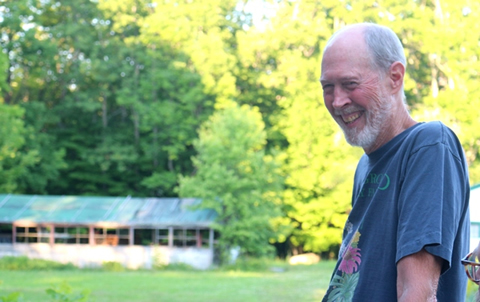Walt Thornton
The Poor Thing, Episode Two

By Walt Thornton (In homage to the original The Poor Thing, a fable by Robert Louis Stevenson)
The Poor Thing began its life one hundred years ago as a summer pavilion on a large farm in central New England. Over the years, it was expanded as the farm changed its function into a camp for children. In its final glorious form, it could seat more than a hundred children, safe from the weather, as they enjoyed food cooked outdoors on a large grill and adjacent motor-driven barbecue spit.
But time had not been kind to the Poor Thing and by 1998, when the Millers River Educational Cooperative acquired it as a part of the Camp Caravan campus, it was indeed poor. Its leaking roof and rotting timbers made it good for no discernable use in the plans for improvement of the property. It was "bitter poor in goods and bitter ugly of countenance," just like the fisherman in the original fable.
Over the years, the group undertook several desultory repairs to slow the Poor Thing’s inevitable aging. But since it served only as a place for scrap wood storage and later, for drying lumber from trees removed to construct the Village School building, it received no serious attention. Over the last twenty years, the Poor Thing slowly declined. Occasionally, a comment would be heard from an odd passing personage—most notably the building inspector, "When are you going to tear that dangerous monstrosity down?" But through it all, the Poor Thing persisted.
The Village School opened the doors of its new building in the fall of 2018. Even though the original plan was to keep the area where the Poor Thing lived apart from Village School activities, slowly those activities began to spread there. First, simply by children walking in the vicinity of the Poor Thing and later, students appropriated the adjacent field to become the second home of daily winter soccer games, whenever the main soccer field became the main soccer bog.
I watched this encroachment with some alarm (but no real noticing) and for many months undertook no repairs, aside from a single Saturday morning effort to remove broken glass from the perimeter of the Poor Thing. And then one day in the late summer of 2019, I did notice the Poor Thing—or perhaps the Poor Thing noticed me. I saw it was time to tend to it and prevent its collapse by installing a metal roof over the existing roof to halt further deterioration, a tactic that has worked well, and often, for other buildings at Camp Caravan.
I contacted our trusty contractor and entrusted the task to him. After one day of careful and gentle demolition of the roof deck, it became apparent that gentle demolition was not called for—firm demolition was. Firm demolition began and soon very little remained of the roof. We decided to install new prefabricated roof trusses and a new metal roof, but to save the Poor Thing’s basic frame. This was decided for no discernable reason except perhaps a feeling which Robert Louis Stevenson described in the original fable:
"The way is plain before all like the grooves of launching: So forth into life and fear not, for so did we all in the ancient ages." … "For in my thought it is a good thing to do what our fathers did, and to keep what they kept without question.” Or as we say today—it seemed like the right thing to do at the time—to try to save at least a part of the structure to connect us with the past.
Most of the old structure for supporting the roof remained. However, as work progressed, we saw we needed to replace portions of it, as well as the old foundations. As we continued to upgrade the old structure I once even heard myself saying, “Of course we must install hurricane ties.”
At one point (point five in the immutable law of process) the realization came that it would have been cheaper and easier to start from scratch with a new building. Nevertheless, we continued with the original plan. I had a strong "knowing" that if the project had developed with the idea that what was needed was to replace the Poor Thing with a new building, with wood storage the only present use, the project would never have begun.
Occasionally, as the project proceeded, I would wonder (or marvel, or lament) how and why it had started. We were spending so much money and time on what appeared to be a virtually useless building, when so many other Camp Caravan projects had a seemingly higher priority. But the project was here and I was “in for a penny, in for a pound.” I was now committed to finishing the project, even if I had to pay for it personally.
The new trusses were delivered, but the work had to stop for the winter snows. When it was time to begin again, the 2020 pandemic arrived. However, we were able to start rebuilding without too much delay, as the building of an open pavilion was the perfect social distancing project.
Finally, in early summer, we completed the project. The Poor Thing was rejuvenated—somewhat like an old hobo with a new silk top hat. It was not the most beautiful pavilion in the world, but perfectly functional. It had become an expensive new structure for the storage of old scrap wood and the proper curing of newly-cut lumber. It was a perfect metaphor for Camp Caravan.
Then only a week after we completed the project, Massachusetts released its autumn 2020 school reopening guidelines. It recommended providing ways for classroom instruction to take place outdoors in the fresh clean virus-free air. Immediately, the Village School Director scrambled to determine how this mandate could be accomplished.
The Poor Thing stood waiting. Its new purpose was about to be fulfilled—the reason it demanded to be noticed.